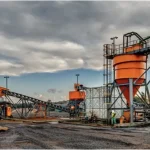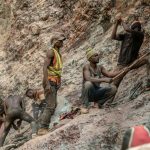In the face of Climate Change, the calls for a sustainable growth agenda are increasingly urgent. Last March the European Commission announced its Circular Economy Action Plan as one of the main blocks of the European Green Deal. This new EU action plan promotes the idea of a circular economy and fosters sustainable processes along the entire life cycle of products, aiming to ensure that the resources used remain in use for as long as possible. The plan focuses on the sectors that use most resources and where the potential for circularity is high, many of which rely on the mining industry for their raw materials.
Mining will play a vital role, as primary resources will continue to be needed due to the growing population and rising per capita consumption, and because it is impossible to close the loop. They are also used for modern applications in energy production and high-tech products. In addition, the sustainable development goals that the United Nations have set up for 2030 are driving the development of green technologies that use a variety of minerals. Mining companies will have to adapt as their customers shift to a circular economy approach, and they will have a key role to play in this transition.
Challenges and opportunities for mining companies
The development of a circular economy in mining presents both challenges and opportunities for mining companies. It has the potential to address the shortage of mineral resources, waste of resources and environmental pollution while generating economic benefits.
The circular-economy approach prioritizes reusing materials over extracting new raw materials. However, the need for virgin materials remains, and wherever they are used, their footprint should be as small as possible.
Also, companies in all industries are under pressure to reduce their environmental impact. This will drive an increase in the demand for sustainably mined products, which poses a challenge for mining companies, but also opens new opportunities.
In order to reduce the footprint of the products they offer, mining companies will need to find ways to maximize the efficiency of their operations to minimize the use of energy and other inputs, while reducing waste as much as possible.
Dr. Mathilde Robben, Key Account Manager at TOMRA Sorting Mining, commented: “Climate Change and the pursuit of sustainable energy are shaping the global economy of the future, driving the transition from a linear to a circular economy model. The mining industry is already adapting and shifting towards a Green Mining approach. As a large consumer of energy, water and chemicals, it is a prime example of a sector where much can be done to reduce the impact on the environment. However, it is vital that it achieves this move towards sustainable practices without losing sight of profitability. TOMRA’s advanced sensor-based sorting technologies address the main challenges the mining industry faces today, such as declining head-grades and increasingly difficult to access ore bodies, rising energy and labor costs, and increased environmental liability, while providing a highly cost-effective solution for mining operations to participate in the circular economy and make the most of the new opportunities it brings.”
The role of sensor-based sorting in the mining circular economy
By investing in new technologies such as TOMRA’s sensor-based sorting, mining companies can take new approaches to extract natural commodities in an energy-efficient and resource-conserving manner.
Installing ore sorting machinery in the early stages of the process has the potential to increase productivity through greater efficiency, as Fred Earnest, President and CEO of Vista Gold Corporation, has experienced with a TOMRA XRT sorter: “Because we’re processing less material, we’re now able to do a finer size. With finer grind our gold recovery has gone up. This has resulted in improvements of grade by 10%; our feed grade to the mill has gone up from 0.84 g/t to now 0.91g/t. We’ve been able to achieve all of this on a capital-neutral basis.”
Sensor-based sorting technology can also significantly increase efficiency in terms of the input resources, such as energy, water and process reagents per ton of product. This significantly reduces the environmental footprint of the operation. Also, in an environment where competition for resources with other stakeholders such as communities and agriculture is increasingly fierce, this can become a driver to obtain the social license to operate.
Grinding is the most energy-intensive part of the production process, and sensor-based sorting has been proven to reduce energy consumption by about half, with a consequent cut in CO2 emissions. It also results in a smaller footprint for the operation and reduces waste material.
TOMRA’s sensor-based ore sorting can contribute to circular economy practices at the mine site level through a proactive management of mining waste dumps and by extending the lifetime of their operation. This technology can recover valuable ore even from sub-economic deposits or dumps, turning marginal waste into value, adding to its significant impact on the sustainability and profitability of the mine.
This was the experience of Engineering and project management company P2E Consulting, which commissioned a TOMRA X-Ray Transmission sorter to replace an existing drum Dense Media Separation (DMS) plant at Eastern Chrome mines in South Africa: “The TOMRA XRT sorter is used to upgrade Under Value (UV) material with a head grade of 20% to 28%, to produce a saleable product at a minimum grade of 38% Cr2O3. It does this efficiently and at a low Cost of Production (COP), with achieving grades in excess of 40% Cr2O3 and mass recoveries of 25 to 30% from scalped waste resulting in Chrome-in-tails as low as 12%. There was no water usage at all and we didn’t need to spend on expensive reagents, so that we are producing Small Lumpy product for approximately 50% of the cost compared to a DMS plant.”
Mining companies are rethinking their operating and business models to address the challenges of Climate Change and to meet the demands of their customers as they shift to circular economy models. TOMRA’s sensor-based sorting technologies can help them participate in the circular economy with Green Mining practices and take full advantage of the opportunities it creates. Its solutions, which range from industrial mineral processes to sorting gemstones, ferrous and non-ferrous metals, other fuels and slag metal, are in operation across the world, each contributing to extending the lifetime of mining operations, increasing the value derived from deposit and productivity, and reducing the environmental footprint of mining companies and their customers.
About TOMRA Sorting Mining
TOMRA Sorting Mining designs and manufactures sensor-based sorting technologies for the global mineral processing and mining industries.
As the world market leader in sensor-based ore sorting, TOMRA is responsible for developing and engineering cutting-edge technology made to withstand harsh mining environments. TOMRA maintains its rigorous focus on quality and future-oriented thinking with technology tailor-made for mining.
About TOMRA
TOMRA was founded on an innovation in 1972 that began with the design, manufacture and sale of reverse vending machines (RVMs) for automated collection of used beverage containers. Today TOMRA provides technology-led solutions that enable the circular economy with advanced collection and sorting systems that optimize resource recovery and minimize waste in the food, recycling and mining industries.
TOMRA has more than ~100,000 installations in over 80 markets worldwide and had total revenues of ~ 9.3 billion NOK in 2019. The Group employs ~4,500 globally and is publicly listed on the Oslo Stock Exchange (OSE: TOM). For further information about TOMRA, please see www.tomra.com
For more information on TOMRA Sorting Mining visit www.tomra.com/mining or follow us on LinkedIn, Twitter or Facebook.















